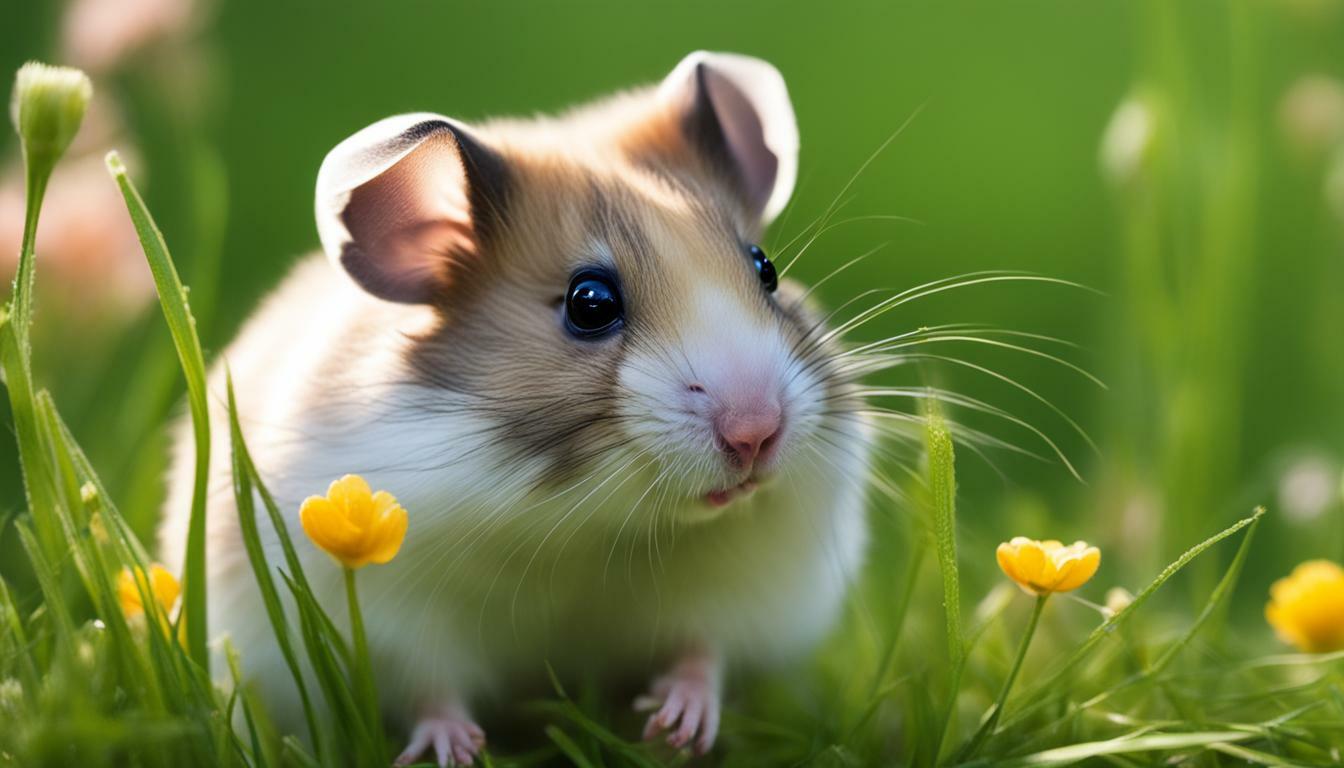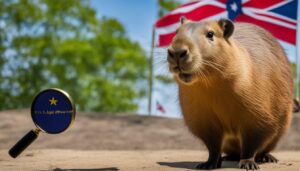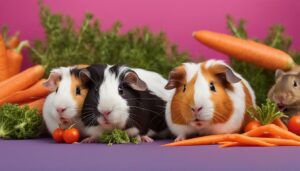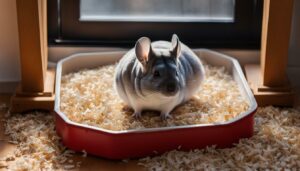Hamsters are curious little creatures that often make us wonder about their dietary preferences. One common question that arises is whether hamsters can eat grass. While hamsters can consume grass, it is important to do so in moderation and with caution.
- Hamsters can eat grass, but it should be given sparingly and in controlled amounts.
- Too much grass can make hamsters sick, and grass treated with chemicals can be harmful.
- Grass is not a necessary part of a hamster’s diet, and they are not able to digest it efficiently.
- A balanced diet for hamsters includes hamster pellets, fresh water, and occasional fruits and vegetables.
- Safe alternatives to grass include spinach, lettuce, and green beans.
The Importance of a Balanced Diet for Hamsters
A balanced diet plays a crucial role in ensuring the overall health and well-being of hamsters. While hamsters are known for their ability to eat a variety of foods, it is essential to provide them with a diet that meets their nutritional needs. This includes a combination of hamster pellets, fresh water, and occasional fruits and vegetables.
Hamsters are small animals with specific dietary requirements. They need a diet that is high in fiber, protein, and essential vitamins and minerals. Hamster pellets are specially formulated to provide these nutrients and should form the basis of their diet. These pellets are designed to meet the specific needs of hamsters and ensure they receive the right balance of nutrients.
In addition to pellets, hamsters can enjoy the occasional treat of fresh fruits and vegetables. These can be offered in small amounts and should be introduced gradually to prevent digestive upset. However, it is important to note that grass is not a necessary part of a hamster’s diet. While hamsters can eat grass, it should be given sparingly and with caution.
| Benefits of a balanced diet for hamsters: |
|---|
| 1. Provides essential nutrients for growth and development |
| 2. Supports a healthy digestive system |
| 3. Promotes strong immune function |
| 4. Helps maintain a healthy weight |
It is important to remember that hamsters are not able to digest grass efficiently. Too much grass can lead to digestive issues and even make them sick. Additionally, grass from a yard that has been treated with chemicals can be harmful to hamsters. Therefore, it is best to limit their intake of grass and ensure it is clean and free from chemicals if offered as a treat.
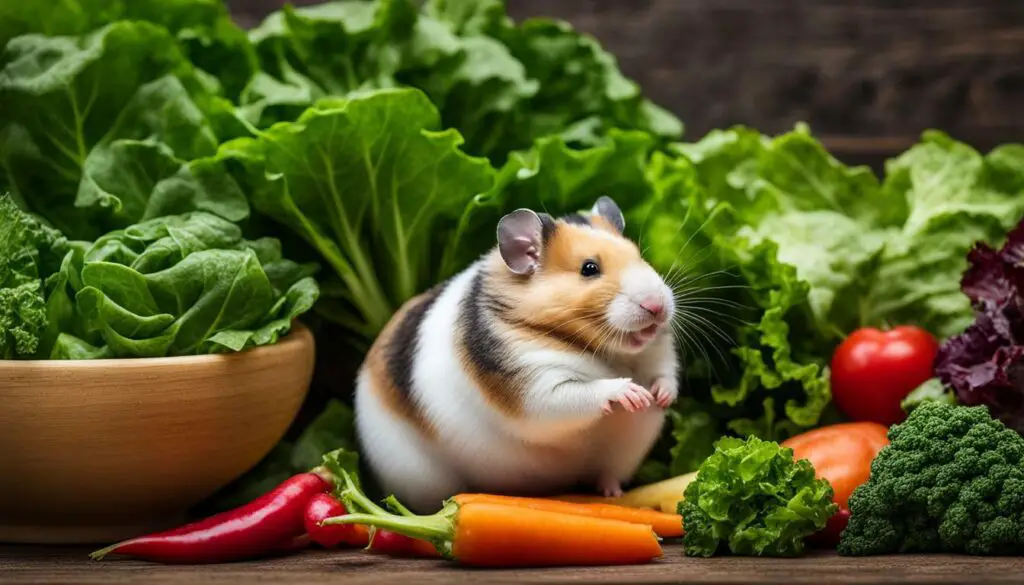
If you are looking for safe alternatives to grass for your hamster, consider incorporating foods like spinach, lettuce, and green beans into their diet. These options provide similar nutritional benefits without the potential risks associated with grass. Remember to introduce new foods gradually to avoid upsetting your hamster’s delicate digestive system.
In conclusion, while hamsters can eat grass, it is crucial to provide them with a balanced diet that meets their nutritional needs. Grass should be given sparingly and in a controlled manner, as too much can cause digestive issues. Focus on offering hamster pellets, fresh water, and occasional fruits and vegetables to ensure their overall health and well-being.
The Role of Grass in a Hamster’s Diet
Grass has been long considered a staple food for various animals, and hamsters are no exception. Although hamsters are primarily herbivores, it is important to note that grass should not be a major part of their diet. While grass can provide certain benefits to hamsters, it should be given in moderation and with caution.
One of the potential benefits of grass for hamsters is its potential to provide essential nutrients. Grass contains vitamins and minerals that can contribute to a hamster’s overall health. Additionally, grass can act as a source of fiber, which is crucial for proper digestion. However, it is important to understand that hamsters are not able to digest grass efficiently, and consuming large quantities can lead to digestive issues.
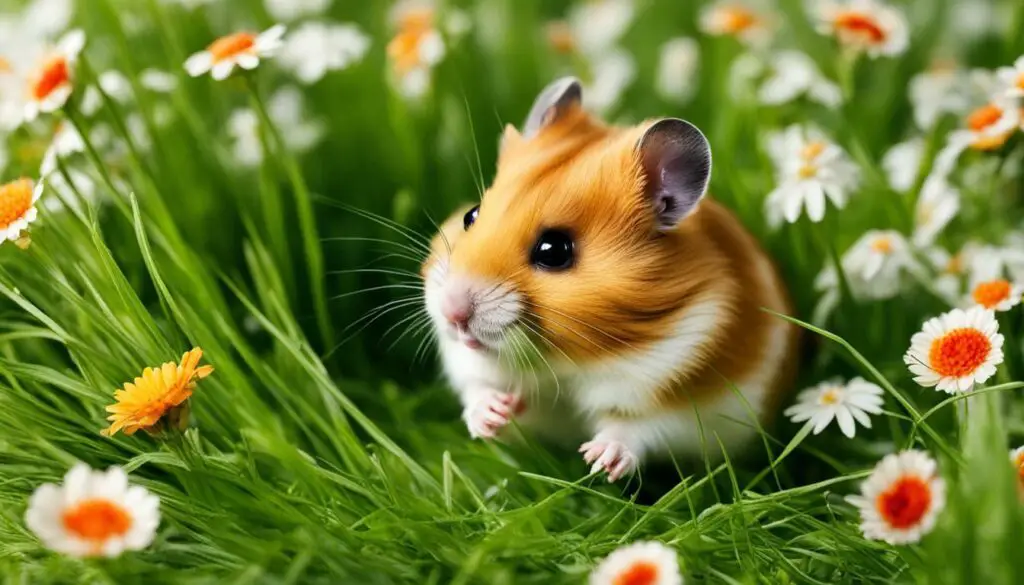
While a small amount of grass can be given to hamsters as a treat, it is essential to ensure that the grass is clean and free of chemicals. Grass from a yard that has been treated with pesticides or other chemicals can be harmful to hamsters. To provide a balanced diet for hamsters, it is recommended to feed them hamster pellets, fresh water, and occasional fruits and vegetables. These foods meet their nutritional needs without the potential risks associated with feeding them grass.
| Benefits of Grass for Hamsters | Considerations |
|---|---|
| Provides essential nutrients | Hamsters cannot digest grass efficiently |
| Acts as a source of fiber | Grass from treated yards can be harmful |
There are also safe alternatives to grass that can be included in a hamster’s diet. Spinach, lettuce, and green beans are some examples of nutritious alternatives that provide similar benefits without the potential risks. When introducing new foods to a hamster’s diet, it is important to do so gradually to avoid upsetting their digestive system.
To conclude, while hamsters can eat grass, it should be given sparingly and in a controlled manner. The focus should be on providing a balanced diet that meets their nutritional needs without relying heavily on grass. By understanding the role of grass in a hamster’s diet and considering safe alternatives, hamster owners can ensure the health and well-being of their furry companions.
Grass as a Treat for Hamsters
If you’re considering giving grass as a treat to your hamster, it’s important to understand the appropriate way to do so. While hamsters can eat grass, it should only be given sparingly and in a controlled manner. Too much grass can make them sick, and grass from a yard that has been treated with chemicals can be harmful to their health. To ensure your hamster’s well-being, follow these guidelines when offering grass as a snack:
- Choose appropriate grass: Opt for clean, fresh grass that has not been treated with any chemicals. Avoid grass from areas where pesticides or herbicides have been used, as these substances can be toxic to your pet.
- Wash the grass: Thoroughly rinse the grass with water to remove any dirt, debris, or potential contaminants. This simple step helps ensure that the grass is safe for your hamster to consume.
- Offer in moderation: Grass should never make up a significant portion of your hamster’s diet. Give only a small amount as an occasional treat, alongside their regular food. This helps prevent digestive issues and maintains a balanced diet.
Remember to always supervise your hamster when offering them grass. Observing their behavior and monitoring their health is crucial to detect any adverse reactions. As with any new food, introduce grass gradually to your hamster’s diet. This allows their digestive system to adjust and minimizes the risk of stomach upset.
Providing a varied and balanced diet is essential for your hamster’s overall health and well-being. While grass can be a healthy snack option, there are other alternatives you can consider to supplement their diet. Spinach, lettuce, and green beans are safe and nutritious options that you can include alongside their regular food. Consult with a veterinarian to determine the best diet plan for your hamster’s specific needs.
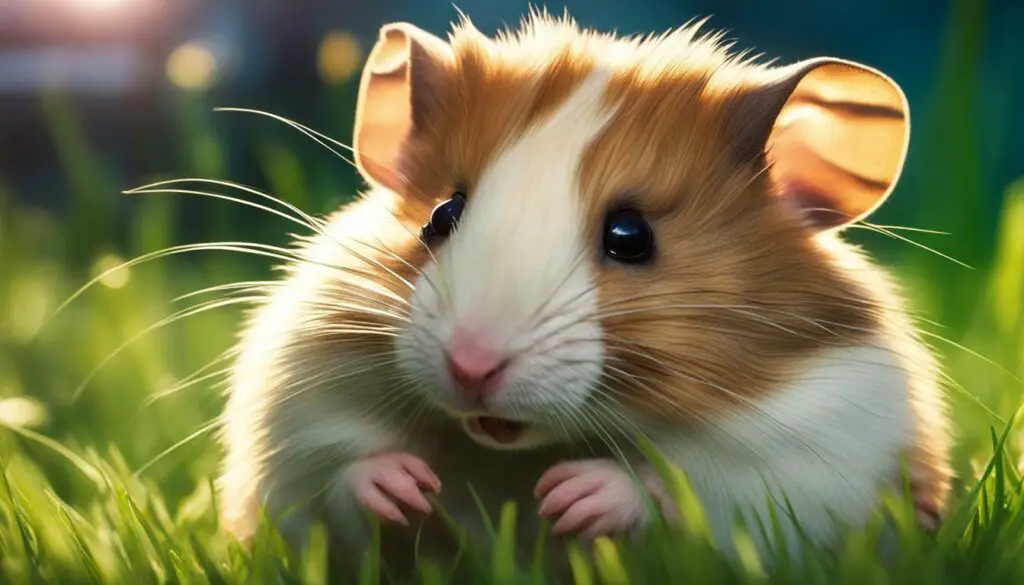
Potential Risks of Feeding Grass to Hamsters
While grass can be enjoyed in moderation, there are potential risks that pet owners should be aware of when it comes to feeding hamsters grass. Hamsters are not able to digest grass efficiently, which can lead to digestive issues if given in large quantities. It is important to understand that grass should not be a major part of their diet and should only be given as an occasional treat.
A common concern is the presence of chemicals in grass, especially if it is sourced from a yard that has been treated with pesticides or herbicides. These chemicals can be harmful to hamsters and may have adverse effects on their health. It is crucial to ensure that the grass provided is clean and free from any chemicals or toxins. Washing the grass thoroughly before offering it to your hamster can help eliminate any potential risks.
Additionally, it is essential to practice moderation when feeding grass to hamsters. Giving them too much grass can lead to gastrointestinal issues such as diarrhea or bloating. It is recommended to offer only a small amount of grass as a treat and monitor your hamster’s reaction. If any signs of discomfort or digestive problems arise, it is advisable to discontinue feeding grass altogether.
Table: Risks of Feeding Grass to Hamsters
| Risks | Description |
|---|---|
| Poor Digestion | Hamsters cannot efficiently digest grass, leading to digestive issues if given in large quantities. |
| Chemical Contamination | Grass sourced from treated yards may contain harmful chemicals that can negatively impact a hamster’s health. |
| Gastrointestinal Problems | Excessive grass consumption can result in diarrhea, bloating, and other digestive problems in hamsters. |
In conclusion, while grass can be a tempting treat for hamsters, it is crucial to be cautious and aware of the potential risks involved. Feeding grass to hamsters should be done sparingly and always in moderation. Additionally, pet owners should ensure that the grass is clean and free from chemicals. It is advisable to provide a balanced diet for hamsters, including hamster pellets, fresh water, and occasional fruits and vegetables, rather than relying heavily on grass as a dietary component.
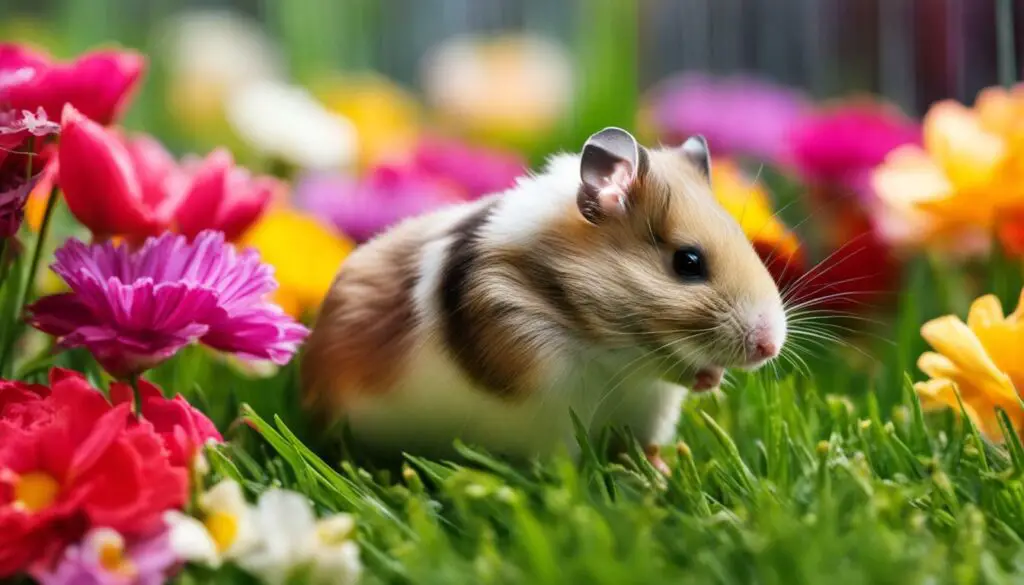
If you’re looking for alternatives to grass to include in your hamster’s diet, there are several safe options to consider. While grass can provide some nutritional benefits, it should be given in moderation and with caution. Thankfully, there are other foods that can offer similar benefits without the potential risks.
One safe alternative to grass for hamsters is spinach. This leafy green vegetable is packed with vitamins and minerals that are essential for their overall health. You can offer small, bite-sized pieces of spinach to your hamster as a nutritious addition to their diet. Just be sure to wash the spinach thoroughly to remove any pesticides or dirt.
Another option is lettuce, which is hydrating and low in calories. Hamsters can enjoy a variety of lettuce types, including romaine, butterhead, and leaf lettuce. It’s important to remove any tough or wilted leaves before serving it to your furry friend. Lettuce can be a refreshing and healthy addition to their diet.
| Safe Alternatives to Grass for Hamsters: |
|---|
| Spinach |
| Lettuce |
| Green beans |
Green beans are another safe and nutritious option for hamsters. They are rich in fiber and provide essential vitamins and minerals. You can offer your hamster small pieces of cooked green beans as a tasty treat. Just make sure to let them cool down before serving.
Remember:
- Introduce new foods gradually to avoid digestive problems.
- Wash all vegetables thoroughly to remove any pesticides or chemicals.
- Offer a variety of safe alternatives to grass to ensure a balanced diet.
By providing your hamster with a diverse diet that includes safe alternatives to grass, you can ensure their health and happiness. Remember to always monitor their reaction to new foods and consult with a veterinarian if you have any concerns. Your furry friend will appreciate the variety and enjoy exploring different flavors!
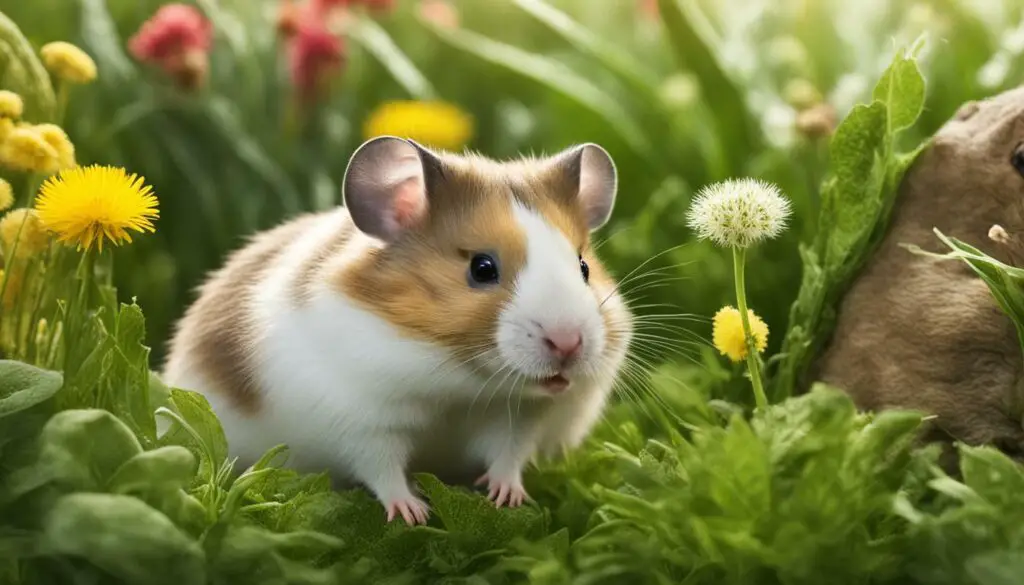
Introducing new foods to a hamster’s diet requires careful consideration and a gradual approach to prevent digestive issues. Hamsters have sensitive digestive systems, and sudden changes in their diet can lead to discomfort and potential health problems. It is important to introduce new foods slowly, starting with small portions and monitoring your hamster’s reaction. This allows their digestive system to adjust and prevents any adverse reactions.
When introducing new foods, it is crucial to choose options that are safe and suitable for hamsters. Leafy greens like spinach and lettuce can be a good choice, as they offer similar nutritional benefits to grass. They should be thoroughly washed and served in small portions at first. Other options include green beans and small pieces of fruits like apples or carrots. These can be given as occasional treats in moderation.
Remember to always monitor your hamster closely when introducing new foods and be observant of any changes in their behavior or digestion. If your hamster shows any signs of distress, such as diarrhea or loss of appetite, discontinue the new food and consult a veterinarian for further guidance. Every hamster is unique, and what works for one may not work for another, so it’s important to pay attention to your furry friend’s individual preferences and needs.
Table: Safe Foods to Introduce to a Hamster’s Diet
| Food | Portion Size | Frequency |
|---|---|---|
| Spinach | Small handful | Once or twice a week |
| Lettuce | A few leaves | Once or twice a week |
| Green beans | A few pieces | Once a week |
| Apples | Small slice | Occasional treat |
| Carrots | Small piece | Occasional treat |
Remember, it is always best to consult with a veterinarian who specializes in small animals if you have any concerns or questions about your hamster’s diet. They can provide personalized advice based on your hamster’s specific needs and health condition. By gradually introducing new foods and taking proper precautions, you can ensure that your hamster enjoys a varied and balanced diet while maintaining good digestive health.
Guidelines for Feeding Grass to Hamsters
If you choose to feed grass to your hamster, it’s essential to follow certain guidelines to ensure their safety and well-being. Grass can be given as a treat, but it should be clean and free from chemicals. Here are some important guidelines to keep in mind:
- Choose safe grass: When giving grass to your hamster, make sure it comes from a safe source. Avoid grass from areas that have been treated with pesticides or other chemicals, as these can be harmful to your pet. Instead, opt for organic or untreated grass that is free from any potential contaminants.
- Wash the grass: Before offering grass to your hamster, it’s important to wash it thoroughly to remove any dirt or debris. This will help ensure that your hamster doesn’t ingest any harmful substances that may be present on the grass.
- Offer a small amount: Grass should only be given to hamsters in small quantities. Too much grass can upset their digestive system and lead to health issues. As a general guideline, offer a small handful of grass as an occasional treat, alongside their regular diet.
- Monitor your hamster: After introducing grass to your hamster’s diet, observe their behavior and health. If you notice any signs of digestive discomfort, such as diarrhea or bloating, discontinue feeding grass and consult a veterinarian for further guidance.
Remember, while grass can be a tasty and natural treat for hamsters, it should be given sparingly. It’s important to provide a balanced diet that includes hamster pellets, fresh water, and occasional fruits and vegetables to meet their nutritional needs.
In addition to grass, there are other healthy alternatives that you can include in your hamster’s diet. Vegetables such as spinach, lettuce, and green beans are packed with essential nutrients and can provide a varied diet for your pet. However, always introduce new foods gradually to avoid digestive upset.
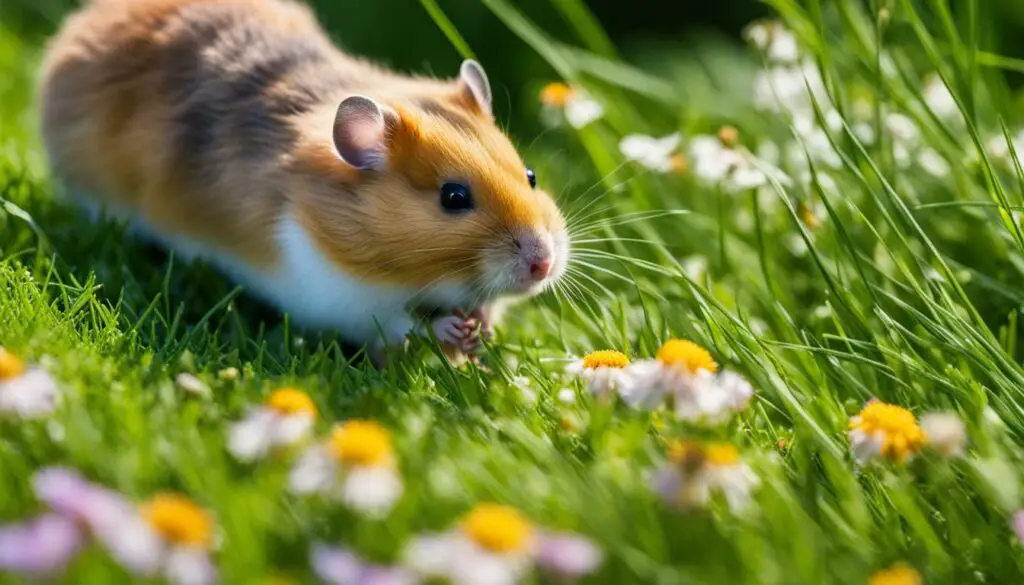
To summarize, if you choose to offer grass as a treat to your hamster, follow these guidelines: choose safe grass, wash it thoroughly, offer a small amount, and monitor your hamster’s health. By doing so, you can ensure that your furry friend enjoys a safe and balanced diet.
Table: Safe Vegetables for Hamsters
| Vegetables | Benefits |
|---|---|
| Spinach | Rich in vitamins A and C, iron, and calcium |
| Lettuce | Provides hydration and dietary fiber |
| Green beans | Source of protein and dietary fiber |
Conclusion
In conclusion, hamsters can enjoy grass as a treat, but it should be given in moderation and with caution to ensure their health and happiness. While grass can provide some benefits to hamsters, it should not be a major part of their diet. Hamsters are not able to digest grass efficiently, which can lead to digestive issues if given in large quantities.
When offering grass to your hamster, it is important to ensure that it is clean and free of chemicals. Grass from a yard that has been treated with pesticides or other chemicals can be harmful to your furry friend. It is best to wash the grass thoroughly before offering it, or consider providing safe alternatives, such as spinach, lettuce, or green beans.
Providing a balanced diet for your hamster is crucial for their overall health and well-being. This includes hamster pellets, fresh water, and occasional fruits and vegetables. While grass can be a fun and flavorful treat, it should not replace the essential components of their diet.
Remember to introduce new foods to your hamster’s diet gradually to avoid upsetting their digestive system. Sudden changes in their diet can lead to health issues. It is also important to monitor your hamster’s reactions to grass or any other new food, and consult a veterinarian if you notice any concerning symptoms.
So, while hamsters can enjoy the occasional nibble of grass, it is best to do so in moderation and with caution. Prioritizing their nutrition and well-being by providing a balanced diet and safe alternative options will ensure that your hamster remains happy and healthy.
FAQ
Q: Can hamsters eat grass?
A: Yes, hamsters can eat grass, but it should be given in moderation and with caution.
Q: Why should grass be given in moderation?
A: Too much grass can make hamsters sick, and grass from a yard treated with chemicals can be harmful to them.
Q: Can hamsters digest grass efficiently?
A: No, hamsters are not able to digest grass efficiently, so it should not be a major part of their diet.
Q: Can hamsters have grass as a treat?
A: Yes, a small amount of clean and chemical-free grass can be given as a treat.
Q: What are the potential risks of feeding grass to hamsters?
A: Feeding hamsters too much grass can cause digestive issues, and grass from chemically treated yards can be harmful.
Q: What are some safe alternatives to grass for hamsters?
A: Spinach, lettuce, and green beans are some safe alternatives to grass that can be included in a hamster’s diet.
Q: How should new foods be introduced to a hamster’s diet?
A: New foods should be introduced gradually to avoid upsetting a hamster’s digestive system.
Q: What are the guidelines for feeding grass to hamsters?
A: Grass should be washed thoroughly, free from chemicals, and only given as a small amount on occasion.
Q: Can feeding grass to hamsters be a major part of their diet?
A: No, grass is not a necessary part of a hamster’s diet and should be given sparingly.

